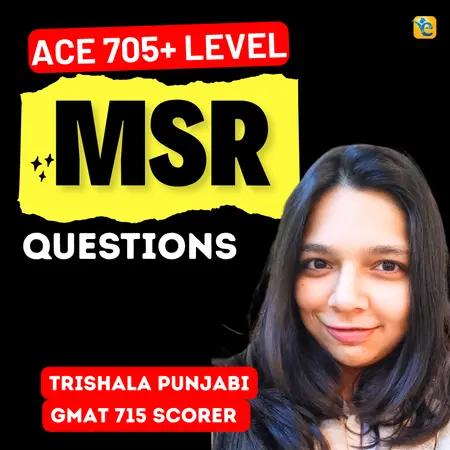Events & Promotions
|
|

GMAT Club Daily Prep
Thank you for using the timer - this advanced tool can estimate your performance and suggest more practice questions. We have subscribed you to Daily Prep Questions via email.
Customized
for You
Track
Your Progress
Practice
Pays
Not interested in getting valuable practice questions and articles delivered to your email? No problem, unsubscribe here.
- Nov 18
11:00 AM PST
-12:00 PM PST
Join us in a live GMAT practice session and solve 30 challenging GMAT questions with other test takers in timed conditions, covering GMAT Quant, Data Sufficiency, Data Insights, Reading Comprehension, and Critical Reasoning questions. - Nov 22
11:00 AM IST
-01:00 PM IST
Do RC/MSR passages scare you? e-GMAT is conducting a masterclass to help you learn – Learn effective reading strategies Tackle difficult RC & MSR with confidence Excel in timed test environment - Nov 23
11:00 AM IST
-01:00 PM IST
Attend this free GMAT Algebra Webinar and learn how to master the most challenging Inequalities and Absolute Value problems with ease. - Nov 25
10:00 AM EST
-11:00 AM EST
Prefer video-based learning? The Target Test Prep OnDemand course is a one-of-a-kind video masterclass featuring 400 hours of lecture-style teaching by Scott Woodbury-Stewart, founder of Target Test Prep and one of the most accomplished GMAT instructors.
B
Be sure to select an answer first to save it in the Error Log before revealing the correct answer (OA)!
Difficulty:
 25%
(medium)
25%
(medium)
Question Stats:
73% (01:33) correct 27%
(01:49)
wrong
27%
(01:49)
wrong  based on 15894
sessions
based on 15894
sessions
History
Date
Time
Result
Not Attempted Yet
Yellow jackets number among the 900 or so species of the world's social wasps, wasps living in a highly cooperative and organized society where they consist almost entirely of females—the queen and her sterile female workers.
A. wasps living in a highly cooperative and organized society where they consist almost entirely of
B. wasps that live in a highly cooperative and organized society consisting almost entirely of
C. which means they live in a highly cooperative and organized society, almost all
D. which means that their society is highly cooperative, organized, and it is almost entirely
E. living in a society that is highly cooperative, organized, and it consists of almost all
A. wasps living in a highly cooperative and organized society where they consist almost entirely of
B. wasps that live in a highly cooperative and organized society consisting almost entirely of
C. which means they live in a highly cooperative and organized society, almost all
D. which means that their society is highly cooperative, organized, and it is almost entirely
E. living in a society that is highly cooperative, organized, and it consists of almost all
Kudos
Bookmarks
A. wasps living in a highly cooperative and organized society where they consist almost entirely of---- wrong because, the reference to ---they-- is ambiguous; it could be wasps, or the 900 or so species or yellow jackets; drop it. In addition, a society is gathering and not a physical place; hence society and where cannot go together.
B. wasps that live in a highly cooperative and organized society consisting almost entirely of --- a good choice using the resumptive modifier wasps that repeats an already stated noun and defines it with further info.
C. which means they live in a highly cooperative and organized society, almost all---- wrong use of ‘which’
D. which means that their society is highly cooperative, organized, and it is almost entirely---- same as in D
E. living in a society that is highly cooperative, organized, and it consists of almost all --- there should be fanboy ‘and’ after cooperative, because the IC --- and it consists of ----is not part of the first list.
B. wasps that live in a highly cooperative and organized society consisting almost entirely of --- a good choice using the resumptive modifier wasps that repeats an already stated noun and defines it with further info.
C. which means they live in a highly cooperative and organized society, almost all---- wrong use of ‘which’
D. which means that their society is highly cooperative, organized, and it is almost entirely---- same as in D
E. living in a society that is highly cooperative, organized, and it consists of almost all --- there should be fanboy ‘and’ after cooperative, because the IC --- and it consists of ----is not part of the first list.
Kudos
Bookmarks
chiayu
Lets make sentence a bit simple....
red ants number among the 900 or so species of the worlds ants, ants living in a highly cooperative and organized society where they consist almost entirely of females- the X and the Y.....
C & D are outright wrong because in " which means" which would refer to ants that cannot mean anything stated later on.
E is wrong because even if "It" may refer to society it is redudant and not parallel...the sentence should have been...
living in a society that is highly cooperative and organized, consisting of almost all...
Now between A&B...
First your query....
An appositive is a noun or noun phrase that immediately follows another noun. An appositive explains or defines the noun it follows and is set off by commas.
eg: Mexico City, the biggest city in the world, has many interesting archaeological sites.
Mexico City = the biggest city in the world
Appositives are always set off by commas. Another interesting aspect of appositives is that they can always be exchanged with the nouns they modify as in another example:
The altitude of Lhasa, the capital of Tibet, is over 12,000 feet.
The altitude of the capital of Tibet, Lhasa, is over 12,000 feet.
So clearly wasps living in a highly cooperative.....is not an appositive but a modifier clause that modifies worlds social wasps...
Now again coming back to a&b
A has a big problem....it says that they consist of....where only logical referrant to they is wasps. But we know that wasps can not consist of females but a society can....
So clearly the Answer is B...














